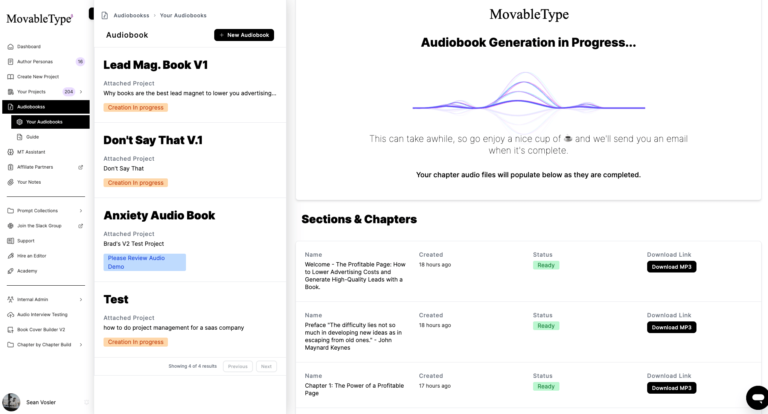
How to Use Your Existing Book Outline to Create a Manuscript Within MovableType.ai
Turn your existing book outline into a structured project with MovableType! This video shows you how to leverage your hard work developing an outline into
Struggling to get your clients the results they need through your agency …
Imagine having the power to turn a single, groundbreaking idea into a …
Enhancing Storytelling with AI: Crafting Compelling Narratives with Advanced Prompts Yes, Artificial …
Struggling to get your clients the results they need through your agency …
Imagine having the power to turn a single, groundbreaking idea into a …
Enhancing Storytelling with AI: Crafting Compelling Narratives with Advanced Prompts Yes, Artificial …
Imagine having the power to turn a single, groundbreaking idea into a fully-formed non-fiction book manuscript of over 30,000 words – all with the help of cutting-edge AI technology. That’s precisely what MovableType.ai offers: the ability to generate a comprehensive, subjective content framework based on your core concepts and arguments. It’s an incredible feat that can save you countless hours of brainstorming, outlining, and drafting.
However, as impressive as MovableType’s AI-generated content is, it’s just the beginning of your journey to creating a best-selling non-fiction book.
In this guide, we’ll walk you through a step-by-step approach to enhancing your MovableType-generated manuscript using Google Docs. You’ll learn how to identify key claims and arguments, conduct focused research to support or refine those ideas, seamlessly integrate objective content, and ultimately create a book that is uniquely yours. Keep reading to learn the tactics and tools that will help you elevate your AI-generated content and bring your vision to life.
There’s a temptation to view Large Language Models (LLMs) like ChatGPT and Claude as omniscient repositories of factual knowledge. However, this perception is not only inaccurate but also dangerous, particularly when it comes to generating non-fiction content. We recognize this pitfall by focusing on SUBJECTIVE outputs as opposed to OBJECTIVE, allowing MovableType to harness the true strengths of LLMs – their ability to articulate creative, persuasive arguments...
LLMs are often mistakenly regarded as search engines on steroids, capable of retrieving objective facts and data on demand. In reality, these models are not designed to store and recall factual information with pinpoint accuracy. Instead, they generate content based on patterns and associations learned during training, which can lead to a phenomenon known as “hallucination” – producing plausible-sounding but factually incorrect statements.
The risk of relying on LLMs for objective content is particularly acute in the realm of non-fiction, where accuracy and credibility are paramount.
LLMs excel at understanding and replicating the patterns of human language, including the structure of compelling arguments, the art of persuasion, and the nuances of rhetorical devices. MovableType.ai harnesses this capability to provide authors with a rich array of ideas, arguments, and linguistic flourishes that can be refined and fact-checked by the human writer.
MovableType.ai’s approach to AI-assisted writing is rooted in the understanding that the most powerful non-fiction arises from a collaborative partnership between human authors and AI tools. The software does not aim to automate the writing process entirely or to replace human judgment and expertise. Instead, it serves as a generative tool that sparks ideas, suggests compelling lines of argument, and offers persuasive language that the author can then shape and mold.
To create a truly comprehensive and credible book, it’s essential to complement this subjective foundation with objective facts and data. This guide will walk you through the process of “editing in the facts” – researching and incorporating objective content to support, refine, or challenge the subjective claims and arguments generated by MovableType.
Begin by reviewing the manuscript generated by MovableType and identifying the central claims, arguments, and premises that form the backbone of your work. Generally doing this one chapter at a time is the best approach, allowing you to
These subjective elements might include:
Make a list of these key subjective components, as they will serve as the starting points for your objective research.

Tactical Tips
With your list of subjective claims and arguments in hand, it’s time to dive into research. The goal is to find objective facts, data, and examples that either support, refute, or nuance the subjective content generated by MovableType.
Here’s a simple research process:
Side Tip: Searching through Book Summaries related to your main topic or the key arguments is a great way to supporting context for your content, often you can related sources that the author of these books has cited to support their claims which you can also reference. It’s always good practice to cite authors and their works that you use in your materials; see this guide for more on when and how to add citations.
As you research, make note of any objective content that you feel adds value to your work. Be sure to record the sources of your information for later citation.
Tactical Tips

With your research complete, it’s time to weave the objective content into your MovableType-generated manuscript.
There are several ways to do this:
As you integrate objective content, be sure to cite your sources and provide links where appropriate. This enhances the credibility of your work and allows readers to explore the topics further.
With the objective content integrated, take a step back and review your manuscript holistically.
Consider:
Make any necessary adjustments to ensure that your subjective and objective content work together harmoniously to create a compelling, well-supported non-fiction work.
MovableType.ai’s capability to generate extensive, high-quality subjective content from a single idea is a remarkable advancement for non-fiction authors. It not only provides a robust framework for your book but also saves you an immense amount of time and effort in the writing process. Developing the skill to write compelling, persuasive prose is a challenging and time-consuming endeavor that often takes years of practice to master. MovableType.ai allows you to bypass this steep learning curve and focus on what truly matters – creating a book that helps and inspires your readers.
By leveraging MovableType’s AI-generated content as a starting point, you can concentrate your efforts on researching, refining, and enhancing the manuscript with objective facts and examples. This process of “editing in the facts” is what transforms the subjective content into a comprehensive, credible work that is distinctly your own.
By combining the AI-generated subjective content with your own research, insights, and refinements, you can efficiently produce a high-quality, impactful book without getting bogged down in the intricacies of subjective writing.
Let MovableType.ai be your launchpad, and use the tactics discussed here to craft a book that not only showcases your ideas but also provides tangible value to your readers.
Citing sources is useful for establishing credibility in your non-fiction work. Here’s a brief guide on how to cite sources both inline and in an optional appendix using the popular MLA (Modern Language Association) format:
Inline citations, also known as parenthetical citations, are brief references placed directly after the quoted or paraphrased material within your text. In MLA format, inline citations typically include the author’s last name and the page number (if available). For example:
If you mention the author’s name in the text itself, you can omit it from the parenthetical citation:
For sources without page numbers (such as websites), simply include the author’s last name:
Here’s an example of a more “casual, in-sentence citation” that provides adequate credit to the source without disrupting the flow of your writing:
According to best-selling author Cal Newport in his book “Deep Work” (page 7), the ability to perform “deep work” – focused, uninterrupted, cognitively demanding work – is becoming increasingly rare in our distracted world.
This type of citation seamlessly integrates the source information into the sentence structure, making it feel more natural and less intrusive. The key components of the citation are still present: the author’s name, the book title, and the specific page number. However, by weaving these details into the sentence itself, you maintain a more conversational and engaging tone.
Here’s another example of this casual citation style:
As Daniel Pink explains in his book “Drive: The Surprising Truth About What Motivates Us” (pages 35-36), extrinsic rewards like bonuses and incentives can actually undermine intrinsic motivation and creativity in the long run.
This approach to inline citation is particularly well-suited for non-fiction works that aim to be accessible and engaging for a broad audience. It allows you to provide the necessary attribution without bogging down your writing with excessive parentheticals or footnotes.
Keep in mind that while this casual citation style is acceptable for many non-fiction contexts, some academic or scholarly publications may require a more formal approach, such as the traditional MLA or APA formats. Always consider your target audience and the conventions of your specific field when deciding on a citation style.
In addition to inline citations, you should include a comprehensive list of all sources cited in your work. This list, often called a “Works Cited” page, should appear at the end of your document. Entries should be alphabetized by the author’s last name and formatted according to MLA guidelines. Here are a few common examples:
Book: LastName, FirstName. Title of Book. Publisher, PublicationYear.
Article in a scholarly journal: LastName, FirstName. “Article Title.” Journal Title, vol. Volume, no. Issue, PublicationYear, pp. Pages.
Website: LastName, FirstName. “Page Title.” Website Name, PublicationDate, URL. Accessed Date.
When citing a source in your appendix, make sure to match the inline citation with the corresponding entry. This allows readers to easily locate and refer to the full source information.
By consistently and accurately citing your sources both inline and in an appendix, you demonstrate the depth of your research, give credit to the original authors, and provide readers with the opportunity to explore the sources themselves. This enhances the overall credibility and value of your non-fiction work.

Turn your existing book outline into a structured project with MovableType! This video shows you how to leverage your hard work developing an outline into

In this Loom, I walk you through the process of adding a table of contents in a Word document. I demonstrate two approaches: one with

In this video, I will guide you through the basic process of creating a print ready (and kindle ready) book cover from the Ai generated

In this video, I will guide you through the basic process of creating your first draft with MovableType.ai. We will start by creating a new

In this video, I will guide you through the basic process of creating your first draft with MovableType.ai. We will start by creating a new

Overview of Creating Audiobooks with MovableType… In this video, I’ll walk you through the important details before you start generating new audiobooks. I’ll explain how